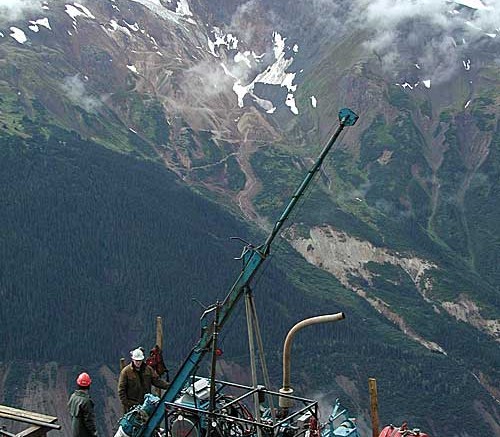Seabridge Gold’s (TSX: SEA; NYSE: SA) chairman and CEO Rudi Fronk says the company anticipates good news from the exploration program it has launched at its KSM gold–copper project in northwestern B.C.
“We expect to announce a lot of positive drill results from this year’s program. I’ve never seen our geologists as excited as they are today,” Fronk says in an interview.
This year’s $15-million, 19,000-metre core drill program has two objectives. First, it aims to improve the size and grade of the inferred resource at the project’s Deep Kerr zone. Second, it will test several high-grade core zone targets, including the Iron Cap deposit at depth, so that it can find other zones similar to Deep Kerr.
The KSM project consists of four large, gold–copper porphyry deposits, including Kerr, Sulphurets, Mitchell and Iron Cap. These deposits occur near surface and have shown vertical continuity down to near-magmatic bornite-bearing core zones, which are usually formed under higher temperatures, resulting in higher metal content, Seabridge explains.
The company’s geologists found the project’s first core zone under the Kerr deposit in late 2012. The firm began drilling the Deep Kerr zone in 2013, and early this year published a maiden inferred resource of 6.1 billion lb. copper and 5.9 million oz. gold based on 515 million tonnes grading 0.36 gram gold per tonne and 0.53% copper.
This zone has the “best metal values found to date at KSM, and is favourably located for cost-effective exploitation” via underground block-cave mining, the company says.
The project’s four main deposits contain reserves of 38.2 million oz. gold and 9.8 billion lb. copper grading 0.55 gram gold and 0.21% copper, along with significant silver and molybdenum by-product credits.
The Deep Kerr discovery has added a large amount of high-grade copper to the previously gold-dominated project, Fronk says. “Before the discovery of Deep Kerr it was really a gold project — 60% of the revenues would have come from gold, the balance from copper and to a lesser extent, silver. With Deep Kerr, though, finding something better than a half-percent copper does change the landscape a little bit.”
Fronk says the zone has attracted base-metal producers, and that before only gold firms were interested in the KSM project.
Along with updating the resource for Deep Kerr, Seabridge aims to determine the northern extension of the zone with stepouts, as well as evaluate the zone’s eastern extension and depth limits.
Deep Kerr is 1.6 km long, extends more than 500 vertical metres, and is 600 metres wide in certain areas. “It’s gigantic,” Fronk says, adding the zone is still open to expansion.
He points out the company’s knowledge and understanding of the KSM system has improved considerably with the large Deep Kerr discovery. “We now know a great deal more about the geophysical and geochemical signatures of the higher-grade core zones we are looking for,” he says.
The junior is confident it will find more core zones mid-year. It intends to focus on the dip projections of the Iron Cap deposit. The best results from the six deep holes drilled in 2013 at Iron Cap returned 207 metres of 1.22 grams gold and 0.45% copper, and 253 metres of 0.9 gram gold and 0.37% copper.
On the social relations and permitting front, Seabridge has signed a benefits agreement with the Nisga’a Nation, where the company will provide employment opportunities at the KSM project, among other commitments. It expects to receive federal and provincial environmental approval in the third quarter.
With $20 million in working capital, Seabridge is well funded to complete this year’s planned exploration and activities.
Another major goal for the company is to secure a joint-venture partner for the KSM project that will “do the heavy lifting and make a decision to build a mine there,” Fronk says. Seabridge has already signed a few confidential agreements and aims to finalize an agreement in the next 12 months.
Seabridge ended June 16 relatively flat at $9.32 per share. It has a $439-million market capitalization.


Be the first to comment on "Seabridge goes deeper at KSM in BC"